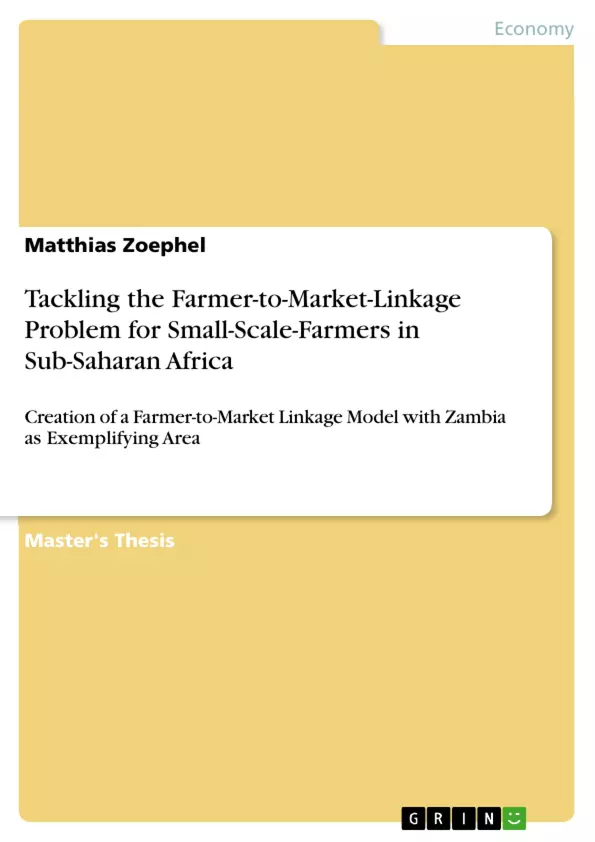African small-scale farmers are inadequately linked to markets to sell their harvested produce. On the one hand this is mainly because farmers are unable to produce according to what is demanded by buyers and on the other hand due to intermediary constraints. This current lack of adequate market linkages prevents farmers to sell their surplus production profitably. While this problem has been widely recognized by NGOs and governmental institutions, little improvements have been made so far. Literature fails to provide an overview of this problem that includes all variables affecting farmers and their linkage to markets. Zambia in particular has received minor consideration in the current literature concerning this problem. Therefore, two NGOs, namely Henwood Foundation and NAK Karitativ, have chosen this Master Thesis to create a farmer-to-market linkage model that incorporates all variables affecting farmers from being inadequately linked to markets while focus is placed on those variables that are amendable to influence by NGOs rather than external variables.
The literature review in the following section two indicates how severe the market linkage problem actually is for small-scale farmers and what possibilities there are to tackle this dilemma. Based on the literature review, the research problem, its goal and its objectives as well as the data collection methods are specified in section three. Section four will provide an introduction to Zambia as well as to Western Province, a state in Zambia, and to Mongu District, a region in Western Province which received the geographical focus of this thesis. Building on this, the farmer-to-market linkage model will receive attention. Section five and six point out preconditions that determine agricultural output, which ultimately decides how well farmers can be linked to markets. Also, actual markets and their demand structure are stated in these sections. Based on sections five and six, the final farmer-to-market linkage model is developed and subsequently discussed in section seven. The thesis concludes with some incitation to solve this dilemma in section eight and a final conclusion outlining limitations of this study and suggestions for further research in section nine.
Inhaltsverzeichnis (Table of Contents)
- Introduction
- Literature Review
- Methodology
- Secondary Data
- Primary Data
- Introduction to the Area under Study
- Introduction to Zambia
- Introduction Western Province/Mongu District
- Market-Linkage Pre-Conditions
- Agro-Ecological Preconditions
- Region - Southern Parts of Western Province
- Region llb - Zambezi Flood Plains Western Province
- Physical Input Preconditions
- Intellectual Preconditions
- Informational Preconditions
- Market Information
- Agro-Ecological Preconditions
- Markets
- Schools
- Healthcare Centers
- Catering Sector
- Supermarkets
- Market Linkage Model
- Discussion and Incitation
- Conclusion
- Limitations and Suggestions
- References
- Appendix
Zielsetzung und Themenschwerpunkte (Objectives and Key Themes)
This thesis explores the challenges faced by small-scale farmers in Western Province, Zambia, in accessing markets for their produce. It aims to develop a market-linkage model that improves the connection between these farmers and potential buyers, ultimately contributing to increased agricultural production and economic prosperity.- The impact of market access on small-scale farmer livelihoods
- Analysis of the market-linkage pre-conditions in Western Province, Zambia
- Development of a market-linkage model tailored to the specific needs of the region
- Evaluation of the feasibility and potential impact of the proposed model
- Recommendations for future research and interventions
Zusammenfassung der Kapitel (Chapter Summaries)
The introduction chapter establishes the context for the study, highlighting the importance of market access for small-scale farmers in Zambia. The literature review chapter explores existing research on market-linkage models and their impact on rural development. The methodology chapter details the research methods employed, including data collection and analysis techniques. The chapter “Introduction to the Area under Study” provides an overview of Zambia and Western Province, including its geographical, demographic, and agricultural features. The chapter “Market-Linkage Pre-Conditions” examines the factors that influence the effectiveness of market linkages in the study area, focusing on agro-ecological, physical, intellectual, and informational pre-conditions. The "Markets" chapter explores potential buyers for small-scale farmer produce, including schools, healthcare centers, the catering sector, and supermarkets. The “Market Linkage Model” chapter presents the proposed model for improving market access, outlining its key components and potential benefits. The "Discussion and Incitation" chapter analyzes the strengths and weaknesses of the proposed model and its potential impact on the region.Schlüsselwörter (Keywords)
The study focuses on market linkages, small-scale farmers, agricultural production, rural development, Western Province, Zambia, agro-ecology, market information, and economic development. The research highlights the importance of improving market access for small-scale farmers, promoting sustainable livelihoods, and contributing to the overall economic well-being of the region.- Citar trabajo
- Matthias Zoephel (Autor), 2011, Tackling the Farmer-to-Market-Linkage Problem for Small-Scale-Farmers in Sub-Saharan Africa, Múnich, GRIN Verlag, https://www.grin.com/document/171130



